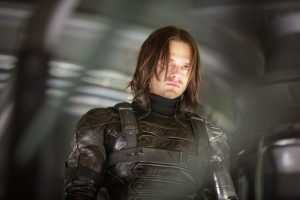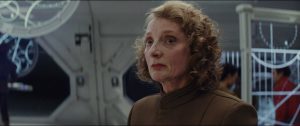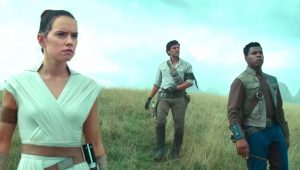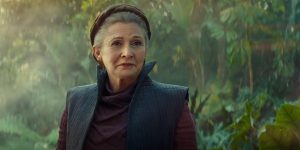Ah, the drama. Earlier this morning, Marvel Cinematic Universe star Sebastian Stan made headlines by seemingly expressing his disappointment with the ending of his Marvel character’s story arc in Avengers: Endgame (and was welcomed by Star Wars star John Boyega into the small but steadily growing community of actors unhappy with how they were treated in the final installment of their respective franchises). I say “seemingly” because it’s kind of unclear whether or not Stan’s vague, single-emoji response to an angry fan’s social media post was an expression of sympathy or not. But since Stan hasn’t clarified his position, and the internet is having a field-day with this story, let’s assume for a moment that Stan really doesn’t like the conclusion to the long and tumultuous history of Bucky Barnes, a.k.a. The Winter Soldier, in the MCU.

First of all, we have to take a look at the post which stirred up all this controversy and drama. The tweet, itself a response to an official Marvel post about Bucky’s relationship with Steve Rogers, a.k.a. Captain America, read: “Together until the end of the line. Or until bad, inconsistent, out-of-character writing turns Steve Rogers into his own anti-thesis. Shouldn’t it be “together until the end of the lie” now?” The author’s harsh condemnation of certain Avengers: Endgame plotlines would have been controversial regardless of whether it was spotted by a certain Marvel actor (who doesn’t even have Twitter, which makes the whole situation even weirder), but the fact that Stan posted a single wide-eyed emoji (which, according to the internet, could mean anything from shock to embarrassment), is what’s got everyone talking. Why is he angry about this whole “end of the line” business anyway, and what would he have preferred to the ending we got?
together until the end of the line. Or until bad, inconsistent, out-of character writing turns Steve Rogers into his own anti-thesis. Shouldn't it be "together until the end of the lie" now?
— Darling Nina 💎- 🐰🌙🗝🔥🧀 (@TheNenya) January 29, 2020
Before we go any further, let me make it clear that I don’t necessarily disagree with either Stan or the fan, but that doesn’t mean this post is going to devolve into an embittered, anti-Endgame tirade. I like Endgame: I like it less now than I did upon first viewing, because I’ve identified many of the film’s flaws, and I’m not entirely satisfied with the many of the film’s decision, especially with regards to the final choices of characters like Tony Stark, Natasha Romanoff, and, yes, Steve Rogers, but I still really like it. I don’t think the Russo Brothers are bad directors, or that Disney/Marvel are evil for not creating the perfect movie, or that anybody has to be “cancelled” by the MCU fandom. I’m not the type to start unnecessary drama (though, if you’d like me to, I could start by saying that Avengers: Infinity War is a complete and utter mess: but I won’t). No, I just want to discuss what I feel is one of the most uninspired and uncomfortable decisions made by the Avengers: Endgame writing team.
Which just so happens to be the conclusion to Steve Rogers’ and Bucky Barnes’ relationship.
In the MCU, these two characters, more than probably any other duo (with the exception of Thor and his brother Loki), have constantly been paired up in increasingly dramatic and thrilling situations that have tested their loyalty to each other time and time again: and yet, despite everything, they’ve always found a way back to each other’s side. Steve gets frozen in the Arctic Ocean for seventy years? No biggie. Bucky is horribly maimed in a wartime accident and becomes the brainwashed servant of a malicious organization operating deep within the most secure counter-intelligence group in the world? Not a problem. Their relationship was important to the plot of Captain America: The First Avenger, crucial (obviously) to Captain America: The Winter Soldier, and pivotal to Captain America: Civil War, in which it was a dispute over Bucky’s safety that led Steve to disobey the Sokovia Accords and start a conflict with Tony Stark that led to the titular civil war which broke up the Avengers, which in turn led to Steve and Bucky going on the run, which in part contributed to Thanos’ victory in Avengers: Infinity War, which set in motion all the events of Avengers: Endgame and thus everything that will happen in the MCU for decades to come. It’s not like Bucky is some side-character: he’s a really big deal.
And then, suddenly, he wasn’t.
At the end of Civil War, Bucky was sent to the African nation of Wakanda to recuperate from his injuries, and since then has shown up a handful of times onscreen, spoken a couple lines of dialogue, and has acted as little more than an extra in fight-scenes. In the post-credits scene of Black Panther, he’s not even that – he wakes up in Wakanda and gets the title of “White Wolf”, which seems to forebode big developments down the line. In Infinity War, he is gifted a seriously cool new vibranium arm that seems designed to wreak havoc on the battlefield but…doesn’t; and then, after being dusted by Thanos, he disappears for five years until the Endgame finale, where he has little more than a cameo as the guy standing silently but supportively behind Steve as he, Steve, makes some of the stupidest decisions of his unnaturally long life. And yes, he’s now getting his own Disney+ series (in which he will co-star alongside Anthony Mackie’s Falcon), but that can’t erase the fact that the conclusion of his relationship with the most important person in his life amounted to a brief exchange using dialogue recycled from their first movie. Meanwhile, Steve gets to enjoy a fairytale ending while everyone else in the MCU suffers irreversible pain and hardship; he goes back in time and unabashedly robs a strong, independent woman of her own agency and story arc, just so he can make good on a promise he made twenty-something movies ago. Was it so absolutely necessary that he have his dance with Peggy Carter, thereby creating his own alternate universe in which she never remarried after his disappearance, or had her own family, or moved on with her life?
No. It was, in my opinion, blatant fan-service that makes little to no sense given everything that has happened to Steve over the years. His entire arc has been one of trying to survive in the modern world, to find purpose and meaning in an era that no longer requires his antiquated morals and services, trying to adapt to society. At first, he fought with tooth and nail and Frisbee-shield: he pined after Peggy and he clung to Bucky, and he shook his head at newfangled customs. But he was beginning to change, to evolve, when Endgame happened – in Winter Soldier, he was forced to take a good long look at the government he had blindly followed into battle for decades, and in Civil War he actually fought back against all forms of government, becoming a rogue anarchist. He even had a new love-interest (albeit one who was related to his former love-interest, which made the whole situation highly disturbing and awkward). And then, after all that development, what does he do, first chance he gets? Hops in a time-machine and fills out an entire lifespan with Peggy Carter, thereby shattering any hope that he would move on with his own life, and stealing Peggy’s own opportunity to do so. And for Sebastian Stan and many other outraged viewers, the worst part of this was that it prevented Steve from having any time to interact with Bucky, a friend he had actually known for some time in both the past and present, and with whom he had a complex, meaningful relationship – for whom he had fought the entire world, for whom he had risked his own life countless times: a friend he had believed in when no one else would.
Steve’s ending is uninspired because it does nothing new with the character, but instead harps back on what made him interesting ten years ago: it reverses years of development in an attempt to make his story come full-circle. And unfortunately, this is similar to what happens to many other Avengers in the same movie: Tony Stark, who spent much of his life wondering how he would die and how many people he could save while doing it, died saving the entire world; Natasha Romanoff, whose every waking moment was spent giving thanks to her family and wondering when she would have to sacrifice everything for them, sacrificed everything, including her life, for them; Clint Barton, who just wanted a boring, middle-American family and a farmhouse in the middle of nowhere, got all that after briefly turning into a bloodthirsty ninja and exacting vengeance on all the Asian crime-lords who had absolutely nothing to do with his family getting dusted by Thanos. Each of those endings tries to employ the full-circle trick, but they almost all fail because the full-circle trick doesn’t always work, and isn’t always that interesting, for the same reason why most people like the concept of free will more than fate – the idea that your destiny is predetermined is, honestly, kind of boring. There’s no surprise, no tension.
I can’t claim to understand what went into the making of Avengers: Endgame, or why the screenwriters and directors chose to do what they did with the story: but one thing that most Marvel fans have noticed (and have already speculated could explain the sudden disappearance of Bucky Barnes) is that soon after The Winter Soldier‘s release, a vocal division of the fandom rose up to demand that Steve and Bucky’s relationship go an extra step further and develop into a romantic dynamic. While both actors, Chris Evans and Sebastian Stan, were very supportive of the idea, it seems that higher-ups at Marvel were nervous even to acknowledge the idea of a Steve/Bucky love story, and tried to backpedal: they gave Steve a new, temporary female love interest, and even wrote in a conversation between the two where they talk about the extremely-straight-and-not-at-all-gay relationships that they had back in the 1940’s. And it didn’t take long before Bucky suddenly started vanishing from the movies and getting less and less screen-time. Maybe this is because of cowardice, or maybe it’s simply because the Russo Brothers didn’t want another gay character distracting from that crucial five-second cameo from the Unnamed Gay Man in Avengers: Endgame, but either way it does seem to have had a negative impact on how Marvel treated Bucky Barnes.
Now, we don’t know if this is why Stan doesn’t like the ending to Steve and Bucky’s relationship (technically, we don’t even know if he doesn’t like their ending). A single emoji can say a lot, but in this case it’s vague enough that I’m basing most of my assumptions off the original tweet, which said the Endgame plotline was “bad” (which is entirely subjective), “inconsistent” (which I’ve argued is an accurate assertion), and “out-of-character” (there’s no good answer to this one: after all, Steve is the character who rebelled against the very political structure that created him, but he’s also the same character who couldn’t even find a prospective date outside of his 1945 girlfriend’s immediate family). Now I leave it up to you, my dear jury, to decide for yourselves who’s right and who’s wrong in this debate. In my personal opinion, I have to agree with many of the claims made in the original tweet, but I’m also not going to sit here and say that Avengers: Endgame is poorly-written, as if it didn’t masterfully handle the extraordinarily large cast of characters across several timelines and in multiple parallel realities, right up until that iffy ending.
So what do you think? Is Sebastian Stan well within his rights to raise his voice, despite still being employed by Marvel (even John Boyega waited until after he was done with Star Wars to give them a piece of his mind), or does he come off as merely disgruntled? What do you, personally, think of the ending to Steve and Bucky’s story, and if you could rewrite it, would you? Share your thoughts, theories and opinions in the comments below!












